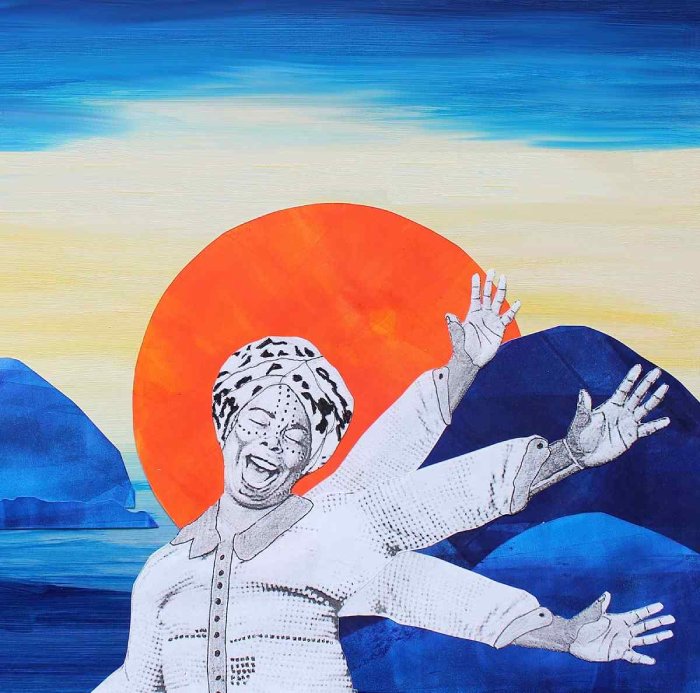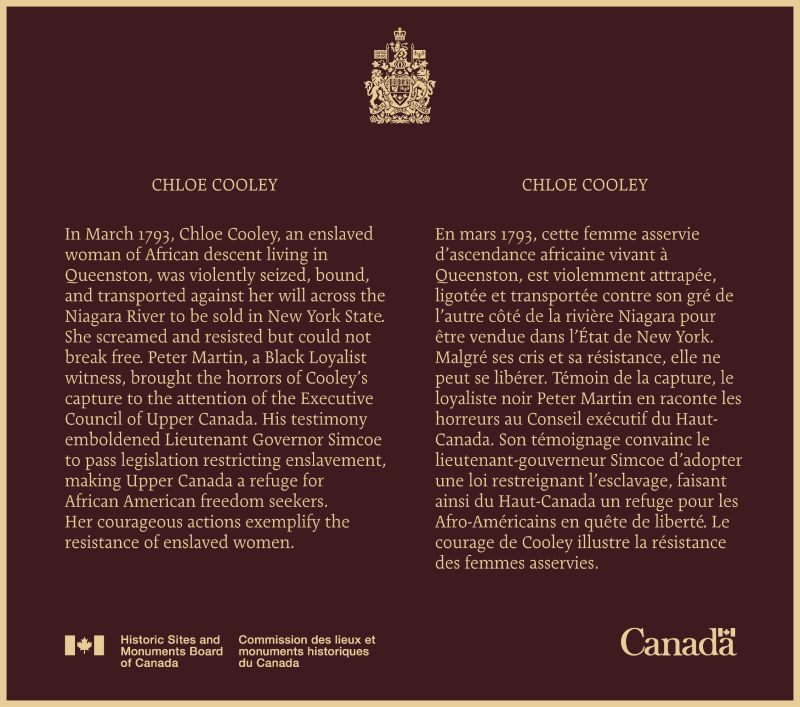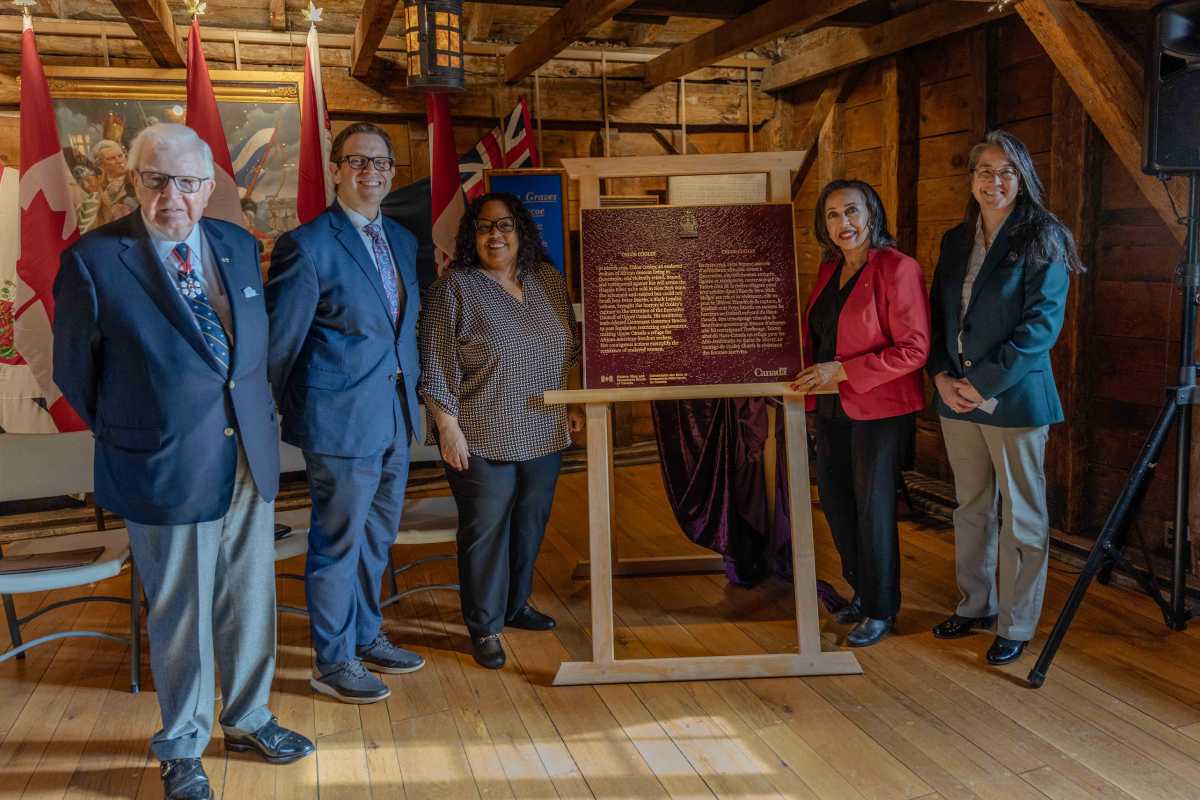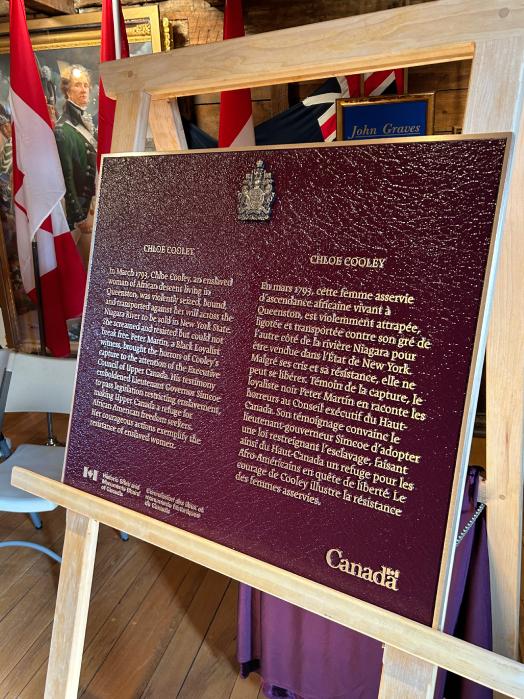Chloe Cooley National Historic Person
Chloe Cooley was designated as a national historic person in 2022.
Historical importance: early example of an enslaved women of African descent who resisted enslavement.
Commemorative plaque: Niagara River Scenic Outlook Point, Queenston Heights Park, OntarioFootnote 1
Chloe Cooley
In March 1793, Chloe Cooley, an enslaved woman of African descent living in Queenston, was violently seized, bound, and transported against her will across the Niagara River to be sold in New York State. She screamed and resisted but could not break free. Peter Martin, a Black Loyalist witness, brought the horrors of Cooley’s capture to the attention of the Executive Council of Upper Canada. His testimony emboldened Lieutenant Governor Simcoe to pass legislation restricting enslavement, making Upper Canada a refuge for African American freedom seekers. Her courageous actions exemplify the resistance of enslaved women.

© Naomi Moyer in collaboration with historian Funké Aladejebi, 2017 / Taken from: https:/graphichistorycollective.com/project/poster-2-chloe-cooley
Chloe Cooley

Chloe Cooley was an enslaved woman of African descent living in Queenston, Upper Canada. Little is known about Cooley’s life, but her courageous resistance against her violent capture and transportation to New York State in 1793 to be sold became a well-known example of the everyday acts of resistance of enslaved women. Although Cooley was unable to escape, Black Loyalist Peter Martin witnessed this incident and testified before a meeting of the Executive Council of Upper Canada. Martin’s testimony describing Loyalist enslaver Adam Vrooman’s treatment of Cooley emboldened Lieutenant Governor John Graves Simcoe to pass legislation limiting enslavement, making Upper Canada a refuge for African Americans seeking freedom.
In March 1793, Adam Vrooman arranged to sell Cooley to an American. Cooley screamed and resisted, and in response, Vrooman bound her with rope to prevent her escape and gagged her to silence her cries. With the help of his brother Isaac Vrooman and a son of Loyalist McGregory Van Every, Adam Vrooman violently forced Cooley into a small boat and transported her across the Niagara River. Once they arrived at the American shore, Cooley screamed and struggled to get loose from her bonds, but she was unable to escape.

© Parks Canada
Though Cooley’s resistance did not result in her freedom, it left a strong impression on Peter Martin, a free man of African descent and a veteran of the American Revolutionary War, and William Grisley (Crisley), a white employee of Vrooman’s. Approximately a week later, on 21 March, the two men testified to her capture before Lieutenant Governor Simcoe and two members of the Executive Council. Though Attorney General John White was instructed to prosecute Adam Vrooman, no charges were laid as he was acting within his legal rights in selling Cooley. This served as a catalyst for Simcoe to instruct the Attorney General to draft legislation imposing limits on enslavement in Upper Canada. Introduced in June 1793, the legislation faced considerable opposition as several members of the House of Assembly and Legislative Council were themselves enslavers.

© Niagara-on-the-Lake Museum Collection

© Parks Canada
Ultimately the Act to prevent the further introduction of Slaves, and to limit the Term of Contracts for Servitude within this Province passed into law, the first legislation of its kind in the British Empire. The Act did not abolish slavery in Upper Canada or free those already enslaved. In fact, it forced any enslaver who freed an enslaved person to post a bond, to avoid creating a financial burden on the province. However, the Act did place limits on indentures (contracts for labour) and declared that children of enslaved persons born after 3 July 1793 would be freed at age 25, and that their children would be free at birth. Further, it banned the importation of new enslaved people into the province, encouraging African American freedom seekers to travel north to Upper Canada. This Act was followed in 1819 by a legal opinion from Attorney General John Beverley Robinson, stating that all persons of African descent entering Upper Canada should be guaranteed freedom, even if they had been enslaved in another country. These legal precedents, and the abolition of slavery in British territories by 1834, helped extend the Underground Railroad into Upper Canada.
“I am pleased that Chloe Cooley is being honoured as a person of national historic significance. As an enslaved Black woman, Chloe Cooley's voice could not be silenced and her success in compelling action around freedom echoes into the present day. In learning about her story, Canadians can better understand that our history is diverse and our future will continue to be built through its diversity.”
“The designation of Chloe Cooley as a person of national historic significance sheds light on some of the injustice and hardship that have been experienced by Black Canadians. I encourage all Canadians to learn more about the designations that reflect on the important contributions of Black Canadians to Canada’s heritage. In sharing these stories, we acknowledge how people of colour continue to unite, impact, and shape our country – and most importantly, our future.”
This press backgrounder was prepared at the time of the plaque unveiling in 2024.
The National Program of Historical Commemoration relies on the participation of Canadians in the identification of places, events and persons of national historic significance. Any member of the public can nominate a topic for consideration by the Historic Sites and Monuments Board of Canada.
- Date modified :